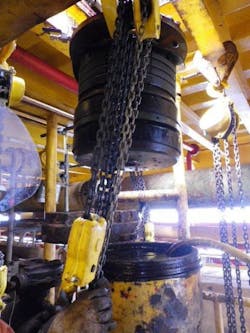Nick Terdre
Contributing Editor
Subsea production is established, so why not subsea drilling? Putting a drilling rig on the seabed would bypass many of the difficulties encountered drilling from the surface on a floating rig.
The idea was conceived by Per Olav Haughom, who conducted a feasibility study for Shell. The conclusion was that it is possible.
Seabed Rig, a company owned by several private investors and StatoilHydro, was established to pursue the project, with Lars Raunholt as CEO. Haughom still is involved as a consultant. The technology development has financial support from the Petromaks and Demo 2000 programs of the Research Council of Norway, and from Innovation Norway and StatoilHydro, says Seabed Rig chief technology officer, Kenneth Mikalsen.
Seabed Rig proposes to place almost the entire drilling operation on the seabed, with control exercised from a surface vessel. The main equipment is the same as applied in a conventional operation, i.e. top-drive, lift, pipe-handler, pipe magazine, roughneck, mud pumps, cement pumps, slips, and BOP. However the shale shaker and cement mixer remain at the surface.
Artist’s impression of the seabed rig.
The seabed drilling rig comprises several modules which are assembled on the seabed to form a structure some 30 m (98.4 ft) high. The resultant module is water tight – the sea cannot enter and no emissions can be released from within. The module is filled with water and pressure-compensated. Water inside is continually circulated and cleaned.
Modules are transported to the well site by the control vessel. This vessel has a moonpool in order to lower the modules to the seabed. As hydrocarbons may be brought on board in the mud return, a hydrocarbon classification also is required. The vessel is connected to the drilling module by an umbilical containing power, communication and supply and return mud flow. There is a separate cement line.
Many building blocks for seabed drilling already exist, Mikalsen says. Various functions on the drill floor have been automated, including that of the roughneck. The company has designed its own mechanical subsea roughneck and has built a prototype. It was tested recently at the IRIS research center in Stavanger, Norway, where it performed remarkably well, Mikalsen claims.
Maintenance issues
With no humans on the spot to sort out problems such as bent pipe sections or stuck valves, a drill floor robot is needed. It will be capable of lifting up to 3,000 kg (6,614 lb).
The robot, which will move around the drill floor on a rail and will be fitted with a hand for performing actions, is under development via a joint project with Stanford University. In May, a contract was awarded to Energid Technologies in the US to produce axis controllers for the robot.
The robot will be programmed to act autonomously, performing functions on command from the operator rather than being manipulated through each different action.
A man/machine interface known as a "visualizator" has been developed to control the drilling operation from the vessel. Using data from multiple sensors on each machine, the visualizator presents the state of each machine in 3D visual form and in real time. It allows the operator to zoom in on any machine, or fly around the roughneck and view its internal functions.
In the first phase of the project, which was concluded last year, the concept was studied in detail to ensure all necessary situations could be managed. All types of machines were evaluated to determine whether the final version should be based on traditional or new designs. The team decided that equipment would be electrically driven and hydraulic functions minimized.
Phase 2, which continues into late 2010, involves construction of a full-scale prototype of the main elements of the subsea drilling rig, including the top-drive, pipe-handling and hoisting machines, the robot, and the control system. This work will culminate with a demonstration of a fully automated, remotely controlled drilling operation.
Seabed Rig aims to bring its technology to the market by 2013 after performing the full-scale under water demonstration, but parts of the system may be available before then, Mikalsen says. By advancing the degree of automation compared with existing equipment, parts, or even the whole system, could prove advantageous in conventional surface drilling applications.
To build the system will cost an estimated NKr 500 million to NKr 1 billion ($80-160 million) mainly because the human element largely has been excluded. For the same reason, the operational cost also should be lower than for a conventional rig.
Another advantage of seabed drilling over surface drilling is the absence of a lengthy riser in deepwater which eliminates the need for heave compensation. Running and pulling the riser are time-consuming. In arctic areas, the interruption of operations by floating ice should be reduced.
In both contexts, not having to maintain a precise station over the well is another significant benefit – the control vessel for the seabed drilling operation is free to drift within a radius of 100 m (328 ft). The day rate for such a unit also should be less than that for mobile units, especially those equipped for harsh weather or deepwater operations.




